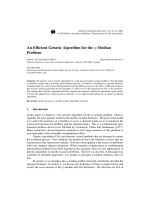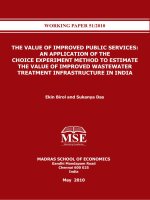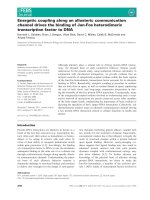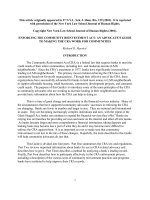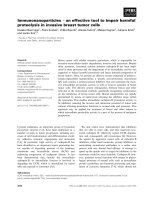Conservation agriculture: An efficient tool to overcome the drawbacks of conventional agricultural system towards sustainable crop production
Bạn đang xem bản rút gọn của tài liệu. Xem và tải ngay bản đầy đủ của tài liệu tại đây (163.6 KB, 8 trang )
Int.J.Curr.Microbiol.App.Sci (2020) 9(7): 1333-1340
International Journal of Current Microbiology and Applied Sciences
ISSN: 2319-7706 Volume 9 Number 7 (2020)
Journal homepage:
Review Article
/>
Conservation Agriculture: An Efficient Tool to Overcome the
Drawbacks of Conventional Agricultural System towards
Sustainable Crop Production
Saju Adhikary1*, Benukar Biswas1 and Anjali Priya2
1
2
Deparment of Agronomy, Bidhan Chandra Krishi Viswavidyalaya
Department of Agricultural Chemistry and Soil Science, Bidhan Chandra Krishi
Viswavidyalaya, Bidhan Chandra Krishi Viswavidyalaya, Mohanpur,
Nadia741252, West Bengal, India
*Corresponding author
ABSTRACT
Keywords
Conservation
agriculture,
Conventional
agriculture,
Constraints,
Resource use
efficiency, Tillage
Article Info
Accepted:
11 June 2020
Available Online:
10July 2020
Conservation Agriculture (CA) consists of the practical application of three
interlinked principles, that is no or minimum tillage, mulching of soil surface and
crop species diversification, in conjunction with other complementary agricultural
practices of integrated crop production. In India several efforts have been made to
develop, refine and disseminate conservation agricultural technologies for the past
two decades and have made significant progress even though there are several
constraints that affect adoption of CA. The technologies used in CA benefit the
environment, increase crop diversification, improve efficient use of resources,
save water and nutrients, increase yields, and provide opportunity to reduce the
cost of production. However, there are several constraints for promotion of CA
technologies, such as lack of appropriate seeders especially for small and medium
farmers, unavailability of skilled and scientific manpower burning of crop
residues, competition of crop residues between their usage in CA and livestock
feeding, and overcoming the biased mindset about tillage. This article reviews the
emerging concerns due to adoption of conventional agriculture systems, and
analyses the constraints and research needs for improvement of conservation
agriculture in India.
Introduction
The major challenges before most of the
Asian countries are attaining food security for
the growing population, alleviating poverty
while sustaining agricultural systems under
the current scenario of depleting natural
resources, alleviating the negative impacts of
climatic variability, spiraling cost of inputs
and volatile food prices. In addition to these
1333
Int.J.Curr.Microbiol.App.Sci (2020) 9(7): 1333-1340
challenges, there are several other constraints
indicating non-sustainability of agricultural
systems including soil erosion, soil organic
matter content reduction, and soil salinization.
These are caused mainly due to: (1) intensive
tillage causing soil organic matter reduction,
soil structural degradation, soil compaction,
surface sealing and crusting, reduced water
infiltration rates, water and wind erosion,(2)
insufficient return of organic material back to
the soil and (3) monocropping. Therefore, a
change in farming practices pattern is
important which can be opted through
elimination of unsustainable conventional
agriculture practices such as, excessive
ploughing/tilling the soil, removing all
organic material and monoculture is crucial
for maintaining future productivity while
sustaining the natural resources. Conventional
agricultural practices consist of extensive soil
tillage, burning of crop residues and external
inputs leading to soil degradation through loss
of organic matter, soil erosion and
compaction. In India more than 70-75%
farmers are small land holders and are major
contributors in total food production but they
are still using traditional farming practices.
Most of the farmers give little attention to the
long term management of natural resources
and can rarely afford inputs such as good
quality seeds and fertilizers, herbicides for
chemical weed management, and heavy
machineries. Conservation agriculture is
targeted to (i) attain high and sustained
production
levels,(ii)achieve
acceptable
profits, and (iii) conserve the environment
(FAO, 2009). It further argues that
conservation agriculture is based on
enhancing natural biological processes
occurring both above and below the soil
surface which goes beyond the scope of zerotillage and therefore provides a range of
technology and management options.
Conservation agriculture practices are
applicable to all the crops, including cereals,
horticulture and plantation crops. However,
these are more popular in rice, wheat, maize,
and soybean. The conservation agriculture
practices promises tremendous potential for
use in different soils and agro-ecological
systems. These are independent of size of
land holdings but their adoption is most
urgently required by smallholder farmers to
save resources, reduce their cost of
production, and increase profit (Derpsch,
2008). The scarcest input to smallholder
farming is farm power that is required for
land
preparation,
crop
establishment,
weeding,
harvesting
and
transport.
Conservation agriculture is practiced to
reduce and eliminate the need for land
preparation for crop production. CA promotes
most soils to have a richer bioactivity and
biodiversity, a better structure, and high
natural physical protection against weather
(raindrops, wind, dry or wet periods). Soil
erosion is therefore highly reduced, soil
agronomic inputs slightly reduced, while
pesticide biodegradation is enhanced. It
protects surface and ground water resources
from pollution and also mitigates negative
climatic effects. Hence, CA provides
excellent soil fertility, saving money, time
and fossil-fuel usage. So, it is an efficient
alternative
to
traditional
agriculture,
attenuating its drawbacks.
Definition of conservation agriculture
Conservation
agriculture
is
a
crop
management system that maintains soil cover
through surface retention of crop residues
with no /zero till and reduced tillage. CA is
described by FAO ( />as a concept of agricultural crop production
which is based on resource saving by
enhancing the natural and biological
processes above and below the ground. As per
Dumanski et al., (2006) conservation
agriculture (CA) is not “business as usual”,
based on maximizing yields while exploiting
the soil and agro-ecosystem resources rather
1334
Int.J.Curr.Microbiol.App.Sci (2020) 9(7): 1333-1340
is based on optimizing yields and profits, to
achieve a balanced agricultural, economic and
environmental benefits. It advocates that the
combined social and economic benefits
gained from combining production and
protection of the environment, including
reduced input and labor costs, are greater than
those from production alone. With CA,
farming communities have become providers
of healthy living environments for the wider
community through reduced usage of fossil
fuels, pesticides, and other pollutants, and
through conservation of environmental
integrity and services. As per FAO definition
CA is to 1) attain high and sustained
production levels, 2) achieve acceptable
profits, and 3) conserve the environment. It
aims at reversing the process of degradation
caused due to the conventional agricultural
practices
like
intensive
agriculture,
burning/removal of crop residues. It can be
referred as a resource efficient or resource
effective agriculture which aims at
conserving, improving and making efficient
use of natural resources through integrated
management of available soil, water and
biological resources in combination with
external inputs.
Principles of conservation agriculture
Conservation agriculture practices followed in
many parts of the world are based on
ecological principles adopting sustainable
land use (Wassmann, 2009; Behera et al.,
2010; Lal, 2013). Adoption of CA is the need
of the hour as a powerful tool for
management of natural resources for
enhancing resource use efficiency (RUE) and
crop productivity to achieve sustainability in
agriculture. Conservation agriculture basically
relies on 3 interlinked principles which must
be considered together for appropriate
designing, planning and implementation
processes. These are:
Minimal mechanical soil disturbance
The soil biological activity provides stable
soil aggregates having varied amounts of
macro and micro pores allowing air
movement and water infiltration. This process
can be called “biological tillage” and it is
incompatible with mechanical tillage. With
mechanical soil disturbance, the biological
soil structuring process is stopped. Minimum
soil
disturbance
maintains
optimum
proportions of gases in the root zone, porosity
for water movement, retention and release,
moderate organic matter oxidation, and limits
the re-exposure of weed seeds and their
germination (Kassam and Friedrich, 2009).
Permanent organic soil cover
A permanent soil cover is important to protect
the soil from the deleterious effect of
exposure to rain and sun, to provide a
constant supply of food to the micro and
macro organisms in the soil and alter the soil
microclimate favourable for optimal growth
and development of soil organisms, including
plant roots which in turn improves soil
aggregation, soil biological activity, soil
biodiversity and carbon sequestration (Ghosh
et al., 2010).
Diversified crop rotations
The rotation of crops is not only necessary to
offer a diverse nutrient supply to the soil
microorganisms, but also for exploring and
recycling different soil layers for nutrients
that have been leached to deeper layers. Crops
diversity in rotation leads to a diverse
population of soil flora and fauna. Cropping
sequence following rotations with legumes
helps in biological nitrogen fixation, minimal
rates of build-up of pest species population
through life cycle disruption, control of offsite pollution and enhancing biodiversity
(Kassam and Friedrich, 2009; Dumanski et
al., 2006).
1335
Int.J.Curr.Microbiol.App.Sci (2020) 9(7): 1333-1340
Table.1 Extent („000 ha) of adoption of CA worldwide by Major five country in 2008/09,
2013/14 and 2015/16
Sl No.
Country
CA area 2008/09
CA area 2013/14
CA area 2015/16
1
USA
26,500.00
35,613.00
43,204.00
2
Brazil
25,502.00
31,811.00
32,000.00
3
Argentina
19,719.00
29,181.00
31,028.00
4
Canada
13,481.00
18,313.00
19,936.00
5
Australia
12,000.00
17,695.00
22,299.00
Source: Derpsch et al., (2018)
Table.2 Cropland area under CA (M ha) by region in 2015/16; CA area as % of global total
cropland, and CA area as % of cropland of each region
Region
CA Cropland
Per cent of global CA
Per cent of Cropland area
area
cropland area
in the region
South America
69.90
38.7
63.2
North America
63.18
35.0
28.1
Australia and
22.67
12.6
45.5
Asia
13.93
7.7
4.1
Russia and
5.70
3.2
3.6
Europe
3.56
2.0
5.0
Africa
1.51
0.8
1.1
Global total
180.44
100
12.5
New Zeland
Ukraine
Source: Derpsch et al., (2018)
Status of conservation agriculture in India
and abroad
Globally, CA is being practiced on about
180,438.64 ha (Table 1). The major CA
practicing countries are USA (43,204.00 ha),
Brazil (32,000.00 ha), Argentina (31,028.00
ha), Canada (19,936.00 ha) and Australia
(22,299.00 ha). In India, CA adoption is still
in its initial phase. Over the past few years,
the major CA based technologies being
adopted is zero-till (ZT) wheat in the ricewheat (RW) system of the Indo-Gangetic
plains (IGP). The conventional agriculture
1336
Int.J.Curr.Microbiol.App.Sci (2020) 9(7): 1333-1340
based crop management systems are gradually
undergoing a shift in model from intensive
tillage to reduced/zero-tillage operations in
other crops and cropping systems. In addition
to ZT, other concepts of CA need to be
included in the system to enhance and sustain
the productivity as well as to exploit new
sources of growth in agricultural productivity.
The CA adoption also offers scope for
diversification through crop intensification in
RW cropping system by following relay
cropping of sugarcane, pulses, vegetables etc.
as intercrop with wheat and maize. The CA
based resource conservation technologies
(RCTs) help in integrating crop, livestock,
land and water management research. In
India, efforts to adopt and promote
conservation agriculture technologies have
been underway for nearly a decade but in the
last 8–10 years these technologies are finding
acceptance by farmers. Efforts to develop and
spread conservation agriculture have been
made through the combined efforts of ICAR
institutes,
several
State
Agricultural
Universities, and the Rice-Wheat Consortium
for the Indo-Gangetic Plains. The spread of
technologies is taking place in India in
irrigated Indo-Gangetic plains where ricewheat cropping systems predominate.
Conservation agriculture systems have not
been tried in other major agro-ecological
regions like rainfed semi-arid tropics and the
arid regions of the mountain agro-ecosystems.
Benefits of conservation agriculture
The benefits of conservation agriculture can
be seen at national, regional and farm level.
The benefits can be classified into three broad
categories: (i) agronomic benefits that
improve soil productivity; (ii) economic
benefits that improve the production
efficiency and profitability; and (iii)
environmental benefits that make agriculture
more sustainable.
Some of the benefits of conservation
agriculture are listed below
Improve the sustainability of different
production systems.
Provides soil as a sink for carbon dioxide,
thereby improves soil organic carbon
content and contributes in reducing global
warming. Conservation agriculture is now
receiving global focus for its carbon
sequestration potential. It has been
estimated that the total potential for soil
carbon sequestration by agriculture could
reduce about 40 per cent of the estimated
annual increase in CO2 emissions (FAO,
2009). The emergence of carbon credit
payments for the farmers practicing
conservation agriculture is now being
considered seriously and expected to
further add to the income of those farmers
who adopt it.
Improves water infiltration and thereby
reduces run-off of surface and ground
water and enhances ground water
recharge.
Improves habitation of organisms, from larger
insects to soil borne fungi and bacteria,
which improve soil biological, physical
and
chemical
properties,
thereby
contributing
to
increasing
crop
productivity.
Reduce cost of production (15-16 per cent) by
saving energy, labor and water, thereby
increasing farm income.
Enhance biodiversity and improves the value
of environmental services.
Reduction in poverty and enhance food and
nutritional security due to higher, more
stable yields and lower food prices.
Constraints for adoption of conservation
agriculture
There are several problems encountered
during adoption of conservation agriculture.
The most important is the mindset of the
farming community who were educated
1337
Int.J.Curr.Microbiol.App.Sci (2020) 9(7): 1333-1340
extensively and convinced about the intensive
agriculture and use of external inputs. In the
past, farmers have realised huge economic
benefits by intensive agriculture practices. A
complete shift from intensive tillage to zero or
minimal tillage needs extensive educational
programme by demonstrating the benefits
accrued by conservation agriculture.
The second problem is related with the high
cost of machines and implements. Farmers in
the Indo-Gangetic plain are small and poor,
thereby may not immediately shift from the
existing
available
machines
to
the
conservation agriculture machines.
The third problem is related to the access to
information about conservation agriculture.
Farmers need detailed information about
tillage practices, different cultivation methods
and use of improved varieties.
The fourth problem is related to skills
development. New machines (zero till
machine) and cultivation practices need skills
development of the farmers. Agro ecological
based conservation agriculture technologies
are available, which need capacity of farmers
to adopt and implement those in their
production environment. Most of the farmers
lack skills in using zero-till machines and
cultivation practices that prevents adoption of
conservation agriculture practices.
Challenges in conservation agriculture
Conservation agriculture as an upcoming
paradigm for raising crops will require an
innovative aspect to deal with management of
varied, flexible and context specific needs of
technologies. Conservation agriculture R&D
(Research and Development), therefore will
call for several innovative features to address
the challenge. Some of these are:
Understanding the system – Conservation
agriculture systems are more complex than
conventional agriculture systems. The main
limitation to the spread of CA system is lack
of site specific knowledge (Derpsch, 2001).
Efficient management of these systems will
be highly demanding in terms of basic
processes and interactions of components
determining the performance of the whole
system. For example, surface maintained crop
residues act as mulch and reduce soil water
losses through evaporation and maintain a
moderate soil temperature regime (Gupta and
Jat, 2010). However, at the same time crop
residues act as a source of easily
decomposable organic matter and could
harbour pest populations. No-tillage systems
will influence penetration depth and
distribution of the root in the soil profile
which, in turn, will influence water and
nutrient uptake and mineral cycling.
Therefore it is important to recognize
conservation agriculture as a system and
develop management strategies accordingly.
Building a system and farming system
perspective – A system perspective is built by
working in partnership with farmers. A group
of scientists, farmers, extension workers and
other stakeholders working in partnership
mode will be critical in developing and
promoting new technologies. This is
somewhat different than in conventional
agricultural R&D, the system is to set
research priorities and allocate resources
within a framework, and little attention is
given to building relationships and seeking
linkages
with
partners
working
in
complementary fields.
Technological challenges – While the basic
principles forming the foundation of
conservation agriculture practices, that is, no
tillage and surface managed crop residues are
well understood, adoption of these practices
under different farming conditions is the
major challenge. These challenges relate to
1338
Int.J.Curr.Microbiol.App.Sci (2020) 9(7): 1333-1340
development, standardization and adoption of
farm machinery for seeding with minimum
soil
disturbance,
developing
crop
management and harvesting systems.
Site specificity – Adapting strategies for
conservation agriculture systems will be
highly site specific. Learning across the sites
will serve as a powerful tool in understanding
why certain technologies or practices are
effective in a set of situations and not
effective in another set. This learning process
will accelerate the building of a knowledge
base for sustainable resource management.
Long-term
research
perspective
–
Conservation agriculture practices, e.g. notillage and surface maintained crop residues
result in resource improvement gradually
therefore benefits come only after a time. In
many situations, yield increase may not come
in the early years of evaluation of impact of
conservation
agriculture
practices.
Understanding the changes and interactions
among physical, chemical and biological
processes is basic to developing improved
soil-water and nutrient management strategies
(Abrol and Sangar, 2006). Therefore, research
in conservation agriculture must have long
term perspectives.
In conclusion, history repeats itself. We
witnessed a shift from organic to inorganic
agriculture and now we are thinking about
moving towards organic agriculture again.
Similarly, earlier no-till system was followed
which was replaced by an excessive till
system, and from there to again no/minimum
tillage system is being followed. Definitely,
conservation agriculture has potential to
improve the use efficiencies of natural as well
as man-made resources, carbon sequestration
and soil health (physical, chemical and
biological). It improves the sustainability of
the agricultural system by mitigating GHG
emission and adapting to climate change.
However, the utilization/ exploitation of the
CA practices needs to be optimized on the
basis of different locations, crops and
cropping systems based on sound benefit-cost
economics. It needs interventions at all levels:
by farmers, researchers, extension personnel
and policy makers to analyse and understand
how conservation theologies integrate with
other technologies that promote CA. It is,
therefore, a challenge for both the scientific
community and farmers to overcome the past
mindset and explore the opportunities that
Conservation Agriculture offers towards
sustainable agriculture development.
References
Abrol, I. P and Sangar, S. 2006. Sustaining
Indian
agriculture-conservation
agriculture the way forward. Current
Science, 91(8), 1020-2015.
Behera, U. K., Amgain, L. P and Sharma, A.
R. 2010. Conservation agriculture:
principles, practices and environmental
benefits. In Behera, U. K., Das, T. K.,
and Sharma, A. R. (Eds.), Conservation
Agriculture, 28-41.
Derpsch, R. 2001. Keynote: Frontiers in
conservation tillage and advances in
conservation practice. In Stott, D. E.,
Mohtar, R. H., and Steinhart, G. C.
(Eds.), Sustaining the global farm.
Selected papers from the 10th
International
Soil
Conservation
Organisation Meeting held May 24-29,
1999 at Purdue University and the
USSA-ARS National Soil Erosion
Research Laboratory.
Derpsch,
R
2008.
No-Tillage
and
Conservation Agriculture: A Progress
Report in eds by Zoebisch, M.A., Y.T.
Gan, W. Ellis, A. Watson and
Sombatpanit, No-till Farming Systems
S. Special Publication No 3, World
Association of Soil and Water
Conservation, Bangkok.
1339
Int.J.Curr.Microbiol.App.Sci (2020) 9(7): 1333-1340
Dumanski, J., Peiretti, R., Benetis, J.,
McGarry, D and Pieri. C.2006. The
paradigm of conservation tillage.
Proceedings of World Association of
Soil and Water Conservation, P1, 58-64.
Dumanski, J., Peiretti, R., Benetis, J.,
McGarry, D., and Pieri. C.2006. The
paradigm of conservation tillage.
Proceedings of World Association of
Soil and Water Conservation, P1, 58-64.
Food and Agriculture Organization of the
United
Nations
(FAO).
2009,
Conservation
Agriculture.
Rome, Italy.
Gupta, R and Jat, M. L. 2010. Conservation
agriculture:
addressing
emerging
challenges of resource degradation and
food security in South Asia. In Behera,
U.K., Das, T.K., and Sharma, A.R.
(Eds.), Conservation Agriculture (pp.118). Division of Agronomy, Indian
Agricultural Research Institute, New
Delhi – 110012, 216 p.
Kassam, A. H and Friedrich, T. 2009.
Perspectives on Nutrient Management
in Conservation Agriculture. Invited
paper, IV World Congress on
Conservation Agriculture, 4-7 February
2009, New Delhi, India.
Kassam, A., Friedrich, T and Derpsch, R.
2018. Global spread of Conservation
Agriculture. International Journal of
Environmental Studies, 1–23.
Lal, R. 2013. Climate-resilient agriculture and
soil Organic Carbon. Indian Journal of
Agronomy, 58(4), 440-450.
Wassmann, R., Jagadish, S.V. K., Sumfleth,
K., Pathak, H., Howell, G., Ismail, A.,
Serraj, R., Redona, E., Singh, R. K and
Heuer, S. (2009. Regional vulnerability
of climate change impacts on Asian rice
production and scope for adaptation.
Advances in Agronomy, 102: 91-133.
How to cite this article:
Saju Adhikary, Benukar Biswas and Anjali Priya. 2020. Conservation Agriculture: An Efficient
Tool to Overcome the Drawbacks of Conventional Agricultural System towards Sustainable
Crop Production. Int.J.Curr.Microbiol.App.Sci. 9(07): 1333-1340.
doi: />
1340

